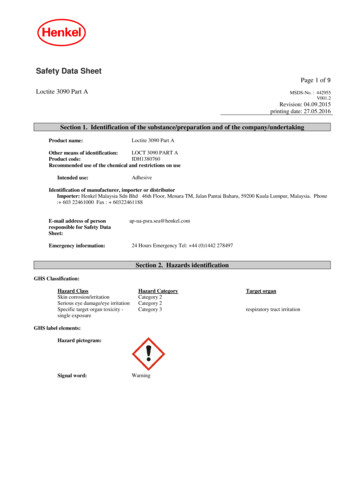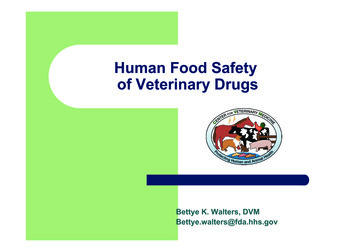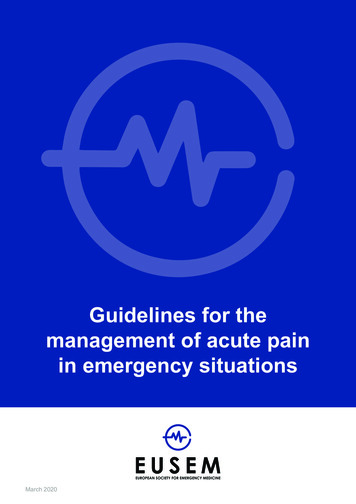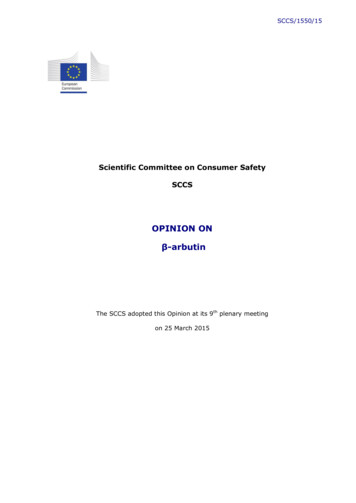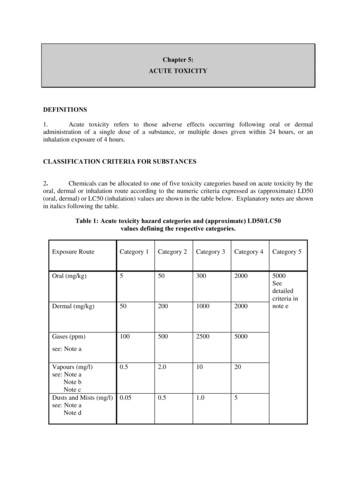
Transcription
Chapter 5:ACUTE TOXICITYDEFINITIONS1.Acute toxicity refers to those adverse effects occurring following oral or dermaladministration of a single dose of a substance, or multiple doses given within 24 hours, or aninhalation exposure of 4 hours.CLASSIFICATION CRITERIA FOR SUBSTANCES2.Chemicals can be allocated to one of five toxicity categories based on acute toxicity by theoral, dermal or inhalation route according to the numeric criteria expressed as (approximate) LD50(oral, dermal) or LC50 (inhalation) values are shown in the table below. Explanatory notes are shownin italics following the table.Table 1: Acute toxicity hazard categories and (approximate) LD50/LC50values defining the respective categories.Exposure RouteCategory 1Category 2Category 3Category 4Category 5Oral (mg/kg)5503002000Dermal (mg/kg)50200100020005000Seedetailedcriteria innote eGases (ppm)100500250050000.52.010200.050.51.05see: Note aVapours (mg/l)see: Note aNote bNote cDusts and Mists (mg/l)see: Note aNote d
Notes to Table 1:a: Inhalation cut-off values in the table are based on 4 hour testing exposures. Conversion ofexisting inhalation toxicity data which has been generated according to 1 hour exposuresshould be by dividing by a factor of 2 for gases and vapours and 4 for dusts and mists.b: It is recognised that saturated vapour concentration may be used as an additional element bysome regulatory systems to provide for specific health and safety protection. (e.g. UNRecommendations for the Transport of Dangerous Goods).c:For some chemicals the test atmosphere will not just be a vapour but will consist of a mixtureof liquid and vapour phases. For other chemicals the test atmosphere may consist of a vapourwhich is near the gaseous phase. In these latter cases, classification should be based on ppmas follows: Category 1 (100 ppm), Category 2 (500 ppm), Category 3 (2500 ppm), Category 4(5000 ppm). Work in the OECD Test Guidelines Programme should be undertaken to betterdefine the terms “dusts”, “mists” and “vapours” in relation to inhalation toxicity testing.d: The values for dusts and mists should be reviewed to adapt to any future changes to OECDTest Guidelines with respect to technical limitation in generating, maintaining and measuringdust and mist concentrations in respirable form.e:Criteria for Category 5 are intended to enable the identification of substances which are ofrelatively low acute toxicity hazard but which, under certain circumstances may present adanger to vulnerable populations. These substances are anticipated to have an oral or dermalLD50 in the range of 2000-5000 mg/kg or equivalent doses for other routes. The specificcriteria for Category 5 are:1) The substance is classified in this Category if reliable evidence is already available thatindicates the LD50 or (LC50) to be in the range of Category 5 values or other animalstudies or toxic effects in humans indicate a concern for human health or an acute nature.2) The substance is classified in this Category, through extrapolation, estimation ormeasurement of data, if assignment to a more hazardous category is not warranted, and :- reliable information is available indicating significant toxic effects in humans; or- any mortality is observed when tested up to Category 4 values by the oral,inhalation, or dermal routes; or- where expert judgement confirms significant clinical signs of toxicity, when tested upto Category 4 values, except for diarrhoea, piloerection or an ungroomedappearance, or- where expert judgement confirms reliable information indicating the potential forsignificant acute effects from other animal studies.Recognising the need to protect animal welfare, testing in animals in Category 5 ranges isdiscouraged and should only be considered when there is a strong likelihood that results ofsuch a test would have a direct relevance for protecting human health.Considerations3.The harmonised classification system for acute toxicity has been developed in such a wayas to accommodate the needs of existing systems. A basic principle set by the IOMC CG/HCCS isthat "harmonisation means establishing a common and coherent basis for chemical hazardclassification and communication from which the appropriate elements relevant to means of transport,consumer, worker and environment protection can be selected." To that end, five categories havebeen included in the acute toxicity scheme.4.The preferred test species for evaluation of acute toxicity by the oral and inhalation routes isthe rat, while the rat or rabbit are preferred for evaluation of acute dermal toxicity. As noted by the2
CG/HCCS, "Test data already generated for the classification of chemicals under existing systemsshould be accepted when reclassifying these chemicals under the harmonised system." Whenexperimental data for acute toxicity are available in several animal species, scientific judgementshould be used in selecting the most appropriate LD50 value from among valid, well-performed tests.5.Category 1, the highest toxicity category, has cut off values of 5 mg/kg by the oral route, 50mg/kg by the dermal route, 100 ppm for gases or gaseous vapours, 0.5 mg/l for vapours, and 0.05mg/l for dusts and mists. These toxicity values are currently used primarily by the transport sector forclassification for packing groups.6.Category 5 is for chemicals which are of relatively low acute toxicity but which, undercertain circumstances, may pose a hazard to especially vulnerable populations. Criteria foridentifying substances in Category 5 are provided in addition to the table. These substances areanticipated to have an oral or dermal LD50 value in the range 2000 - 5000 mg/kg or equivalent dosesfor other routes of exposure. In light of animal welfare considerations, testing in animals in Category5 ranges is discouraged and should only be considered when there is a strong likelihood that results ofsuch testing would have a direct relevance for protecting human health.Special Considerations for Inhalation Toxicity7.Values for inhalation toxicity are based on 4 hour tests in laboratory animals. Whenexperimental values are taken from tests using a 1 hour exposure, they can be converted to a 4 hourequivalent by dividing the 1 hour value by a factor of 2 for gases and vapours and 4 for dusts andmists.8.Units for inhalation toxicity are a function of the form of the inhaled material. Values fordusts and mists are expressed in mg/l. Values for gases are expressed in ppm. Acknowledging thedifficulties in testing vapours, some of which consist of mixtures of liquid and vapours phases, thetable provides values in units of mg/l. However, for those vapours which are near the gaseous phase,classification should be based on ppm. As inhalation test methods are updated, the OECD and othertest guideline programs will need to define vapours in relation to mists for greater clarity.9.Vapour inhalation values are intended for use in classification of acute hazard for all sectors.It is also recognised that the saturated vapour concentration of a chemical is used by the transportsector as an additional element in classifying chemicals for packing groups.10.Of particular importance is the use of well articulated values in the high toxicity categoriesfor dusts and mists. Inhaled particles between 1 and 4 microns mean mass aerodynamic diameter(MMAD) will deposit in all regions of the rat respiratory tract. This particle size range corresponds toa maximum dose of about 2 mg/l. In order to achieve applicability of animal experiments to humanexposure, dusts and mists would ideally be tested in this range in rats. The cut off values in the tablefor dusts and mists allow clear distinctions to be made for materials with a wide range of toxicitiesmeasured under varying test conditions. The values for dusts and mists should be reviewed in thefuture to adapt to any future changes in OECD or other test guidelines with respect to technicallimitations in generating, maintaining, and measuring dust and mist concentrations in respirable form.CLASSIFICATION CRITERIA FOR MIXTURESConsiderations11.The criteria for substances classify acute toxicity by use of lethal dose data (tested orderived). For mixtures, it is necessary to obtain or derive information that allows the criteria to beapplied to the mixture for the purpose of classification. The approach to classification for acute3
toxicity is tiered, and is dependent upon the amount of information available for the mixture itself andfor its ingredients. The flow chart of Figure 1 below outlines the process to be followed:Figure 1: Tiered approach to classification of mixtures for acute toxicityTest Data on the Mixture as a WholeNoSufficient dataavailable on similarmixtures to estimateclassification hazardsNoYesYesApply bridgingprinciples paragraphs15-22CLASSIFYYesAvailable datafor all ingredientsNoApply formula inparagraph 334CLASSIFYApply formula inparagraph 24CLASSIFYYesOther data availableto estimateclassificationNoConvey hazards of theknown ingredients Apply formula in paragraph 24(unknown ingredients 10%) or Paragraph 28 (unknowningredients 10%)CLASSIFY12.Classification of mixtures for acute toxicity can be carried out for each route ofexposure, but is only needed for one route of exposure as long as this route is followed (estimated ortested) for all ingredients. If the acute toxicity is determined for more than one route of exposure, themore severe hazard category will be used for classification. All available information should beconsidered and all relevant routes of exposure should be identified for hazard communication.13.In order to make use of all available data for purposes of classifying the hazards of themixtures, certain assumptions have been made and are applied where appropriate in the tieredapproach:a) The “relevant ingredients” of a mixture are those which are present in concentrationsof 1% (w/w for solids, liquids, dusts, mists and vapours and v/v for gases) or greater,unless there is a presumption that an ingredient present at a concentration of less than1% can still be relevant for classifying the mixture for acute toxicity.1b) The acute toxicity estimate (ATE) for an ingredient in a mixture is derived using: 1The LD50/LC50 where available,this is particularly relevant in the case of ingredients classified in Category 1 and Category 2.4
The appropriate conversion value from Table 2 that relates to the results of arange test for an ingredient, orThe appropriate conversion value from Table 2 that relates to a classification forthe ingredientc) Where a classified mixture is used as an ingredient of another mixture, the actual orderived acute toxicity estimate (ATE) for that mixture may be used when calculating theclassification of the new mixture using the formulas in paragraph 24 - 28.Classification of Mixtures Where Acute Toxicity Test Data are Available for the CompleteMixture.14.Where the mixture itself has been tested to determine its acute toxicity, it will be classifiedaccording to the criteria that have been agreed for substances. In situations where such test data forthe mixture are not available, the procedures presented below should be followed.Classification of Mixtures Where Acute Toxicity Test Data are not Available for the CompleteMixture.Bridging Principles15.Where the mixture itself has not been tested to determine its acute toxicity, but there aresufficient data on the individual ingredients and similar tested mixtures to adequately characterise thehazards of the mixture, these data will be used in accordance with the following agreed bridging rules.This ensures that the classification process uses the available data to the greatest extent possible incharacterising the hazards of the mixture without the necessity for additional testing in animals.Dilution16.If a mixture is diluted with a substance that has an equivalent or lower toxicity classificationthan the least toxic original ingredient, and which is not expected to affect the toxicity of otheringredients, then the new mixture may be classified as equivalent to the original mixture.Alternatively, the formula explained in paragraph 24 could be applied.17.If a mixture is diluted with water or other totally non-toxic material, the toxicity of themixture can be calculated from test data on the undiluted mixture. For example, if a mixture with anLD50 of 1000 mg/kg were diluted with an equal volume of water, the LD50 of the diluted mixturewould be 2000 mg/kg.Batching18.The toxicity of one production batch of a concentration mixture can be assumed to besubstantially equivalent to that of another production batch of the same commercial product, andproduced by or under the control of the same manufacturer, unless there is reason to believe there issignificant variation such that the toxicity of the batch has changed. If the latter occurs, newclassification is necessary.Concentration Of Highly Toxic Mixtures19.If a mixture is classified in Category 1, and the concentration of the ingredients of themixture that are in Category 1 is increased, the new mixture should be classified in Category 1without additional testing.5
Interpolation Within One Toxicity Category20.For three mixtures with identical ingredients, where A and B are in the same toxicitycategory and mixture C has toxicologically active ingredients with concentrations intermediate tothose in mixtures A and B, then mixture C is assumed to be in the same toxicity category as A and B.Substantially Similar Mixtures21.Given the following:a).b).c).d).Two mixtures:(i) A B(ii) C BThe concentration of ingredient B is essentially the same in both mixtures.The concentration of ingredient A in mixture (i) equals that of ingredient C in mixture (ii)Data on toxicity for A and C are available and substantially equivalent, i.e. they are in thesame hazard category and are not expected to affect the toxicity of B.If mixture (i) is already classified by testing, mixture (ii) can be assigned the same hazard category.Aerosols22.An aerosol form of a mixture may be classified in the same hazard category as the tested,non aerosolised form of the mixture for oral and dermal toxicity provided the added propellant doesnot affect the toxicity of the mixture on spraying. Classification of aerosolised mixtures for inhalationtoxicity should be considered separately.Classification of Mixtures Based on Ingredients of the Mixture (Additivity Formula).Data Available For All Ingredients23.In order to ensure that classification of the mixture is accurate, and that the calculation needonly be performed once for all systems, sectors, and categories, the acute toxicity estimate (ATE) ofingredients should be considered as follows: Include ingredients with a known acute toxicity, which fall into any of the GHS acute toxicitycategories.Ignore ingredients that are presumed not acutely toxic (e.g., water, sugar).Ignore ingredients if the oral limit test does not show acute toxicity at 2,000 mg/kg/body weight.Ingredients that fall within the scope of this paragraph are considered to be ingredients with a knownacute toxicity estimate (ATE).24.The ATE of the mixture is determined by calculation from the ATE values for all relevantingredients according to the following formula below for Oral, Dermal or Inhalation Toxicity:100Ci ATE mixη ATE iwhere:Ci concentration of ingredient in ingredients and i is running from 1 to nATEi Acute Toxicity Estimate of ingredient iData Are Not Available For One Or More Ingredients Of The Mixture.6
25.Where an ATE is not available for an individual ingredient of the mixture, but availableinformation such as listed below can provide a derived conversion value, the formula in paragraph 24may be applied.This may include evaluation of:(a)Extrapolation between oral, dermal and inhalation acute toxicity estimates1.Such an evaluation could require appropriate pharmacodynamic andpharmacokinetic data;(b)Evidence from human exposure that indicates toxic effects but does notprovide lethal dose data;(c)Evidence from any other toxicity tests/assays available on the substance thatindicates toxic acute effects but does not necessarily provide lethal dose data;or(d)Data from closely analogous substances using structure/activity relationships.26.This approach generally requires substantial supplemental technical information, and ahighly trained and experienced expert, to reliably estimate acute toxicity. If such information is notavailable, proceed to the provisions of paragraph 27.27.In the event that an ingredient without any useable information at all is used in a mixture at aconcentration of 1% or greater, it is concluded that the mixture cannot be attributed a definitive acutetoxicity estimate. In this situation the mixture should be classified based on the known ingredientsonly, with the additional statement that x percent of the mixture consists of ingredient(s) of unknowntoxicity.28.If the total concentration of the ingredient(s) with unknown acute toxicity is 10% then theformula presented in paragraph 24 should be used. If the total concentration of the ingredient(s) withunknown toxicity is 10%, the formula presented in paragraph 24 should be corrected to adjust for thetotal percentage of the unknown ingredient(s) as follows:100 ( C unknown if 10% )ATEmix ηCiATEiTable 2: Conversion from the experimentally obtained acute toxicity range estimates or aclassification to point estimates for the respective routes of exposure.Oral(mg/kg )1.Classification or experimentallyobtained acute toxicity rangeestimate (see note 1)0 Category 1 55 Category 2 5050 Category 3 300300 Category 4 20002000 Category 5 5000Conversion value(note 2)0.551005002500For ingredients with acute toxicity estimates available for other than the most appropriate exposure route, valuesmay be extrapolated from the available exposure route to the most relevant route. Dermal and inhalatory routedata are not always required for ingredients. However, in case data requirements for specific ingredients includeacute toxicity estimates for the dermal and inhalatory route, the values to be used in the formula need to be fromthe required exposure route.7
)0 Category 1 5050 Category 2 200200 Category 3 10001000 Category 4 20002000 Category 5 50000 Category 1 100100 Category 2 500500 Category 3 25002500 Category 4 5000Category 50 Category 1 0.50.5 Category 2 2.02.0 Category 3 10.010.0 Category 4 20.0Category 50 Category 1 0.050.05 Category 2 0.50.5 Category 3 1.01.0 Category 4 5.0Category .5Note1:Category 5 is for mixtures which are of relatively low acute toxicity but which under certaincircumstances may pose a hazard to vulnerable populations. These mixtures are anticipatedto have an oral or dermal LD50 value in the range of 2000-5000mg/kg or equivalent dose forother routes of exposure. In light of animal welfare considerations, testing in animals inCategory 5 ranges is discouraged and should only be considered when there is a stronglikelihood that results of such testing would have a direct relevance for protecting humanhealth.Note2:These values are designed to be used in the calculation of the ATE for a mixture based on itscomponents and do not represent test results. The values are conservatively set at the lowerend of the range of Categories 1 and 2, and at a point approximately 1/10th from the lowerend of the range for Categories 3 – 5.HAZARD COMMUNICATIONAllocation of Label Elements29. General and specific considerations concerning labelling requirements are provided inChapter 4. Annex 3 contains examples of precautionary statements and pictogramswhich can be used where allowed by the competent authority. Additional referencesources providing advice on the use of precautionary information is also included.8
Table 3: Acute Toxicity Label ElementsCategory 1Category 2Category 3Category 4Category 5SymbolSkull andCrossbonesSkull andCrossbonesSkull andCrossbonesExclamationMarkNo symbol isusedSignal t:Fatal ifswallowedFatal ifswallowedToxic ifswallowedHarmful ifswallowedMay be harmfulif swallowed--Oral--Dermal--InhalationFatal in contact Fatal in contact Toxic in contact Harmful inwith skincontact withwith skinwith skinskinMay be harmfulin contact withskinFatal if inhaled Fatal if inhaled Toxic if inhaled Harmful ifinhaledMay be harmfulif inhaledAdditional Information for Category 5 Classification30.As provided in Note e to Table 1, classification into Category 5 involvesconsideration of additional criteria, beyond the values contained in the classification table.When considering these criteria, the following guidance should be kept in mind.31.“Reliable information” is considered to be information from tests that are conductedaccording to internationally recognised scientific principles.Effects Considered to Support Classification31. “Significant signs of toxicity” include:significant functional changes in the central or peripheral nervous systems or other organ systems,including signs of central nervous system depression and effects on special senses (e.g., sight,hearing and sense of smell).Any consistent and significant adverse change in clinical biochemistry, haematology, orurinalysis parametersSignificant organ damage that may be noted at necropsy and/or subsequently seen or9
confirmed at microscopic examination.Multifocal or diffuse necrosis, fibrosis or granuloma formation in vital organs withregenerative capacity.Morphological changes that are potentially reversible but provide clear evidence ofmarked organ dysfunction.Evidence of appreciable cell death (including cell degeneration and reduced cell number)in vital organs incapable of regeneration.Effects Considered Not To Support Classification32.It is recognised that effects may be seen that would not justify classification.Examples of such effects in humans and/or animals are include: clinical observations or smallchanges in bodyweight gain, food consumption or water intake that may have sometoxicological importance but that do not, by themselves, indicate "significant" toxicity10
33.Classify in Category 5 ifassignment to a more hazardousclass is not warrantedDecision Tree for Classification of Acute ToxicityDoes the substance/mixture have an:LD50 # 5 mg/kg (oral)LD50 # 50 mg/kg (dermal)LC50 # 100 ppm (gas)LC50 # 0.5 (mg/l) (vapour)LC50 # 0.05 (mg/l) (dust,mist)Y Yes YCategory 1No\Does the substance/mixture have an:LD50 between 5 and less than 50 mg/kg (oral)LD50 between 50 and less than 200 50 mg/kg (dermal)LC50 between 100 and less than 500 ppm (gas)LC50 between 0.5 and less than2.0 (mg/l) (vapour)LC50 between 0.05 and less than 0.5 (mg/l) (dust,mist)Y Yes YCatetory 2No\Does the substance/mixture have anLD50 between 50 and less than 300 mg/kg (oral)LD50 between 200 and less than 1000 mg/kg (dermal)LC50 between 500 and less than 2500 ppm (gas)LC50 between 2.0 and less than 10.0 (mg/l) (vapour)LC50 between 0.5 and less than 1.0 (mg/l) (dust,mist)Category 3Y Yes YNo\Does the substance/mixture have anLD50 between 300 and less than 2000 mg/kg (oral)LD50 between 1000 and less than 2000 mg/kg (dermal)LC50 between 2500 and less than 5000 ppm (gas)LC50 between 10.0 and less than 20.0 (mg/l) (vapour)LC50 between 1.0 and less than 5.0 (mg/l) (dust,mist)Category 4Y Yes YNo\Category 5Y Yes YDoes the substance/mixture have anLD50 between 2000 and 5000 (oral)Is there reliable information is available indicatingsignificant toxicity effects in humans?No\11No\Y Yes Y
Was any mortality is observed when tested up toClass 4 values by the oral, inhalation or dermalroutes?Classify in Category 5 if assignment to amore hazardous class is not warranted.Y Yes YNo\Y Yes YIs there expert judgement that confirms significantclinical signs of toxicity, when tested up to class 4values, except for diarrhoea, piloerection or anungroomed appearance?Y YesYYIs there expert judgement that confirms reliable informationindicating the potential for significant acute effects from otheranimals?No\Classify in Category 5 if assignment to amore hazardous class is not warranted.Classify in Category 5 if assignment toa more hazardous class is not warranted.No\Substance is not acutely toxic12
40.Classification and Labelling SummaryDoes the substance/mixture meet the criteria below?No º The substance/mixture is not classified as a acutely toxic.Yesº See the hazard communication elements appropriate to the criteria.Category 1Category 2Category 3Category 4CriteriaHazard Communication ElementsLD50 # 5 mg/kg (oral)LD50 # 50 mg/kg (dermal)LC50 # 100 ppm (gas)LC50 # 0.5 (mg/l) (vapour)LC50 # 0.05 (mg/l) (dust,mist)Signal WordDangerSymbolSkull and CrossbonesHazardStatementLD50 between 5 and less than 50 mg/kg (oral)LD50 between 50 and less than 200 50 mg/kg(dermal)LC50 between 100 and less than 500 ppm(gas)LC50 between 0.5 and less than2.0 (mg/l)(vapour)LC50 between 0.05 and less than 0.5 (mg/l)(dust,mist)LD50 between 50 and less than 300 mg/kg(oral)LD50 between 200 and less than 1000 mg/kg(dermal)LC50 between 500 and less than 2500 ppm(gas)LC50 between 2.0 and less than 10.0 (mg/l)(vapour)LC50 between 0.5 and less than 1.0 (mg/l)(dust,mist)LD50 between 300 and less than 2000 mg/kg(oral)LD50 between 1000 and less than 2000 mg/kg(dermal)LC50 between 2500 and less than 5000 ppm(gas)LC50 between 10.0 and less than 20.0 (mg/l)(vapour)LC50 between 1.0 and less than 5.0 (mg/l)(dust,mist)Signal WordFatal if swallowed. (oral)Fatal in contact with skin(dermal)Fatal if inhaled (gas, vapour,dust, mist)DangerSymbolSkull and CrossbonesHazardStatementFatal if swallowed. (oral)Fatal in contact with skin(dermal)Fatal if inhaled (gas, vapour,dust, mist)Signal WordDangerSymbolSkull and CrossbonesHazardStatementToxic if swallowed. (oral)Toxic in contact with skin(dermal)Toxic if inhaled (gas,vapour, dust, mist)Signal WordWarningSymbolExclamation MarkHazardStatementHarmful if swallowed. (oral)Harmful in contact with skin(dermal)Harmful if inhaled (gas,vapour, dust, mist)13
Category 5LD50 between 2000 and 5000 (oral)Signal WordWarningSee also the additional criteria (para xx)SymbolNo symbolHazardStatementMay be harmful ifswallowed (oral)May be harmful in contactwith skin (dermal)May be harmful if inhaled(gas, vapour, dust, mist)Additional Acute Toxicity Criteria:41.A substance is classified in Category 5, if assignment to a more hazardous class is notwarranted, through extrapolation, estimation or measurement of data if:-reliable information is available indicating significant toxicity effects in humans- any mortality is observed when tested up to Category 4 values by the oral,inhalation or dermal routes.- where expert judgement confirms significant clinical signs of toxicity, whentested up to Category 4 values, except for diarrhoea, piloerection or an ungroomedappearance, or- where expert judgement confirms reliable information indicating the potential forsignificant acute effects from other animals.14
42.EXAMPLESMIXTURE A CONTAINING HAZARDOUS SUBSTANCE YSubstance Y is used as a carpet cleaner and supplied as mixture A that is an 18%solution of substance Y in water. How should mixture A be classified and labelled?In order to reach a conclusion about the classification and labelling of mixture A, we mustfirst define how its components are classified. As water is not classified as hazardous, itis the classification of substance Y that is of importance here.Classification and labelling of substance YWe have data available from published literature to indicate that substance Y is acutelytoxic but is not hazardous to health in other ways.The acute toxicity is summarised in the table below.Type of studyExperimental resultsGHS CategoryRat, single oraladministrationRat, single 4-hourinhalation to the vapourDermal administrationATEi 200 mg/kgCategory 3ATEi 5 mg/lCategory 3No dataNo classificationThe ATEi (Acute Toxicity Estimate of the substance) is calculated from an acute toxicity,single exposure study and indicates the exposure level that is associated with severe signs oftoxicity in the species studied.See paragraph 2 for the acute toxicity classification criteria.Therefore the classification of substance Y is as follows:Acute Toxicity Category 3 (by the oral and inhalation routes)Although not needed for the classification of Mixture A, the labelling of Substance Y canbe determined at this point. Given that it is in Category 3 for acute toxicity, reference toTable 3, paragraph 29 shows that the following label information is appropriate:Signal wordSymbolHazard statementsDangerSkull & crossbonesToxic if swallowed and if inhaled15
Classification and labelling of mixture AThere are no toxicological data available for mixture A and therefore according to theclassification criteria (paragraph 23-24) its classification and labelling must bedetermined by a calculation method using a standard equation.As indicated above, we need only consider the hazard of substance Y and thecalculations that are required are shown below.The classification criteria define the equation 100/ATEmix ATEi /%,where: ATEi is the Acute Toxicity Estimate of substance A;ATEmix is the Acute Toxicity Estimate of mixture Y; and% is the percentage value of substance A in mixture Y.This standard equation can be expressed alternatively asATEmix 100 x ATEi /%.As we know that mixture A contains 18% of substance Y, the value of the % term is 18.We can determine the classification of the mixture as follows:Acute oral toxicity: ATEi 200 mg/kgATEmix 100 x 200/18ATEmix 1111 mg/kgThe ATEmix value of 1111 mg/kg indicates Class 4 is appropriate.Acute inhalation:ATEi 5 mg/l (vapour)ATEmix 100 x 5/18ATEmix 27.8 mg/lThe ATEmix value of 27.8 mg/l indicates Category 5 is appropriate
limitations in generating, maintaining, and measuring dust and mist concentrations in respirable form. CLASSIFICATION CRITERIA FOR MIXTURES Considerations 11. The criteria for substances classify acute toxicity by use of lethal dose data (tested or derived). For mixtures, it is necessary to obtain or derive information that allows the criteria .


